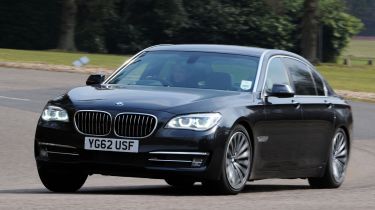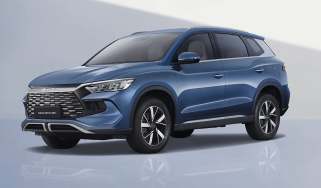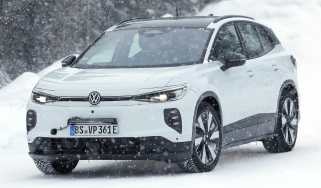BMW ActiveHybrid 7
The BMW ActiveHybrid 7 is great fun to drive, but will poor fuel returns count against it?
If you spend more time driving than being driven, the BMW should be on your shortlist. It’s ferociously fast and great fun. Yet it doesn’t feel special inside, plus its powerful hybrid isn’t that efficient. As with the A8, diesels make more sense.
Despite being a relative newcomer to the hybrid market, BMW has embraced the eco-friendly technology with open arms. As a result, buyers can now choose ActiveHybrid versions of its 3, 5 and 7 Series.
Essentially, all three use the same hybrid drivetrain, which connects a twin-turbo 3.0-litre straight six petrol to a lithium-ion battery-powered 40kW electric motor that’s mounted between the engine and standard eight-speed automatic gearbox. BMW claims that this hi-tech combination can deliver a diesel-rivalling 41.5mpg at the pumps, while emitting only 158g/km of CO2.
But it’s the performance, rather than the economy, that stands out. With the smooth and muscular straight-six working in unison with the electric motor, the 7 Series was able to sprint from 0-60mph in only 5.5 seconds, which was 1.1 seconds faster than the Lexus. Yet it combines this scorching performance with an ability to travel around two-and-a-half miles at speeds of up to 37mph in all-electric mode.
Used - available now

2022 BMW
7 Series
93,519 milesAutomaticPetrol3.0L
Cash £37,179
2019 BMW
7 Series
39,270 milesAutomaticDiesel3.0L
Cash £26,995
2019 BMW
7 Series
101,433 milesAutomaticDiesel3.0L
Cash £16,990
2019 BMW
7 Series
112,094 milesAutomaticPetrol2.0L
Cash £14,499However, you’ll need to be extremely gentle with the throttle to get the most out of the electric motor, because unlike the Lexus and Audi, there’s no EV mode. Get it right and the 7 Series will glide silently along using battery power only. Unfortunately, even when trying to maximise electric range, the BMW returned a poor 23.1mpg.
As with its rivals, there’s little to mark the petrol-electric 7 Series out from other models in the range, with the only obvious change being the chrome ActiveHybrid 7 badges on the C-pillars. And while you’d struggle to call the BMW attractive, it is at least more imposing than the anonymous A8.
The changes to the interior are equally low-key, with the addition of a charge/boost gauge and a small ActiveHybrid logo on the centre console. However, delve into the menus displayed on the car’s huge 10.2-inch colour screen, and you’ll find graphics that show the flow of power between the petrol and electric motors, plus a bar chart that illustrates the last 15 minutes of energy use. Elsewhere, the cabin is standard long-wheelbase 7 Series, which means top-notch quality and plenty of space, particularly for passengers in the back.
But while the interior is beautifully built from first-rate materials, it lacks the feel-good factor of the Audi and Lexus. For instance, the dashboard looks far too similar to that of the 5 Series executive saloon, and the three-spoke steering wheel has been lifted straight from the entry-level 1 Series.
The addition of hybrid technology also hurts the BMW’s practicality, as the boot volume shrinks from 510 litres to 460 litres, which is 40 litres more than the Lexus’. Still, for most limousine customers, comfort is more important than practicality – and the 7 Series doesn’t disappoint in this respect.
With air-suspension at the rear and standard adaptive dampers, the BMW floats serenely over bumps, while there’s minimal noise on the motorway. Better still, it matches this relaxing refinement to surprisingly agile handling – the steering is direct, body control is strong and there’s plenty of grip.
However, these are strengths the hybrid 7 Series shares with its diesel counterpart, which is cheaper and more efficient. Will that hold it back at the finish?



